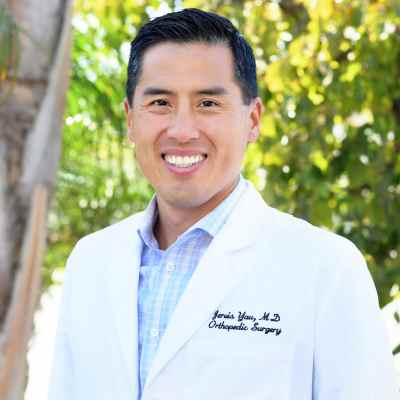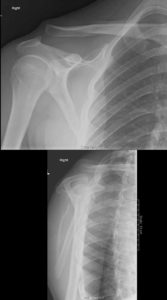AC Joint Injury / Separated Shoulder Specialist

Are you an athlete who participates in contact sports? If so, you may be at risk of separating your shoulder. A separated shoulder is typically caused by blunt trauma to the shoulder or by a fall onto the shoulder. Separated shoulder specialist, Dr. Jervis Yau provides diagnosis and both surgical and nonsurgical treatment options for patients in Santa Barbara who have suffered a shoulder separation. Contact Dr. Yau’s team today!
Shoulder Joint Pain Caused by an AC Joint Injury (Separated Shoulder):
The acromioclavicular (AC) joint serves to connect the clavicle (collarbone) to the tip of the scapula (shoulder blade) known as the acromion. The AC joint is held together by strong ligaments to prevent the shoulder from collapsing into the chest wall during shoulder motion. An AC joint injury typically occurs from direct trauma to the top of the shoulder during a hit or fall. The injury can range in severity from a mild sprain to a complete separation leading to acromioclavicular joint pain and deformity. Dr. Jervis Yau, Santa Barbara, Goleta, Santa Maria and Ventura, California area orthopedic shoulder specialist, specializes in treating injuries to the AC joint and returning patients to the activities they enjoy.
AC joint injury causes damage to both the cartilage and ligaments that hold the joint together that allow for normal function. Injuries to the AC joint are graded on a 1-6 scale based on severity.
AC joint injury grade:
- Grade 1: AC joint pain, normal X-rays
- Grade 2: AC joint sprain, slight elevation of distal clavicle (<25% displacement) on X-rays
- Grade 3: AC joint separation, elevation of distal clavicle (25-100% displacement) on X-rays
- Grade 4: AC joint separation, distal clavicle completely displaced posteriorly through trapezius
- Grade 5: AC joint separation, elevation of distal clavicle (>100% displacement) on X-rays
- Grade 6: AC joint separation, distal clavicle is completely separated inferiorly (rare)
What are the Symptoms of a Separated Shoulder?
With all injury grade levels, acromioclavicular joint pain (pain within the shoulder) are the hallmark symptoms. Patients with a grade 1-3 injury often experience minor swelling, tenderness and mild deformity, while more serious grade injuries (grade 4-6) often cause patients to experience severe pain, swelling, visible deformity and inability to lift the arm.
How is an AC Joint Injury Diagnosed?
In order to confirm diagnosis of an AC joint injury, Dr. Yau must perform a comprehensive history and physical examination. These injuries are typically diagnosed with X-rays although a MRI scan may be obtained to rule out additional injuries to the shoulder.
What is the Treatment for an AC Joint Injury?
Non-Surgical
Grade 1-2 injuries to the AC joint are generally treated conservatively with a sling followed by rehabilitation when the pain and inflammation subsides. In order to alleviate acromioclavicular joint pain and facilitate healing, patients will be instructed to ice the injured area, rest the joint and take anti-inflammatory medications. Over time, patients may be prescribed a physical therapy program to restore strength, function and mobility to the shoulder.
Grade 3 injuries are controversial and can be treated effectively with either surgery or conservative treatment programs. Dr. Yau will typically evaluate the individual and determine the optimal treatment based on age, activity level, patient expectation and severity of injury.
Surgical
Grade 4-6 AC joint injuries and those who fail conservative treatment will typically require surgical repair for best results. Dr. Yau generally uses a minimally invasive, arthroscopic approach to repair and stabilize the AC joint back to its anatomical state.
For additional resources on acromioclavicular joint pain, or for more information on AC joint injury treatment, please contact the Santa Barbara, Goleta, Santa Maria and Ventura, California orthopedic office of shoulder specialist Dr. Jervis Yau.
